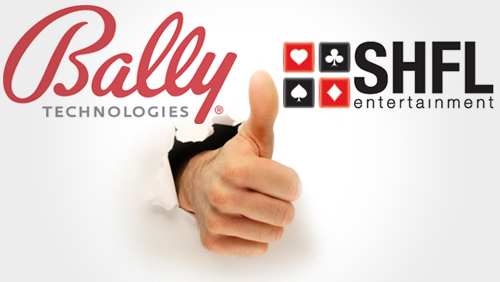 “Its international strength would be of interest as well for an acquirer, who could use SHFL’s existing relationships to market their own products in Latin America – and most importantly for any gaming operator – Asia…The best fit here would be Bally Technologies (BYI), who saw less than 14% of its revenue in the last two quarters come from overseas.”
“Its international strength would be of interest as well for an acquirer, who could use SHFL’s existing relationships to market their own products in Latin America – and most importantly for any gaming operator – Asia…The best fit here would be Bally Technologies (BYI), who saw less than 14% of its revenue in the last two quarters come from overseas.”
So I wrote about SHFL Entertainment (SHFL) back in February, in listing the most likely acquisition targets in the gambling industry. And, lo and behold, just five months later, Bally announced a $1.3 billion acquisition of SHFL in an all-cash deal.
But before I go dislocating my shoulder trying to pat myself on the back, I should probably remember this disastrous prediction and also point out that the Bally-SHFL merger simply made too much sense not to happen. Beyond its international reach, SHFL offers substantial recurring revenue from leasing, licensing, and servicing of its utility products (such as automatic shufflers), electronic gaming machines and its proprietary table games such as Three Card Poker and Ultimate Texas Hold ‘Em. As I noted earlier this year, the recurring revenue makes the predicted benefits of the acquisition easier to explain, and easier to defend, to board members, shareholders, and analysts. SHFL’s table gaming products do not compete directly with Bally’s slot portfolio; indeed, Bally CEO Ramesh Srinivasan emphasized on his company’s fourth quarter conference call that “there’s definitely going to be no revenue cannibalization of any sort” in the wake of the combination. Instead, the two companies should create a sum greater than its parts, as the combination of the two companies allows for the consolidated entity to expand its ability to sell products all across casino floors (and websites) all around the world. All told, it seems like a perfect marriage.
The market would seem to agree. Bally shares gained nearly 7 percent on the day of the announcement, and continued to race higher over the next month, hitting an all-time high of $75.61 on Friday after releasing fiscal 2013 earnings, before falling back in late trading to close at $70.51. (Fears about guidance for next year appear to have been the culprit in the quick change in sentiment.) SHFL shares would gain 22 percent on the day the merger was announced, as Bally’s offer of $23.25 per share in cash represented a 24 percent premium to SHFL’s day-prior close of $18.70. SHFL now trades at $22.73 per share, a modest discount to Bally’s offer price. With the merger expected to close “no later than” June 15th of next year, the discount seems appropriate, given the months-long wait for the full purchase amount. What it does show, however, is that the market does not expect a second bidder to come forward with a higher price. (For instance, in the wake of merger announcement with Pinnacle Entertainment (PNK), Ameristar Casinos traded above its $26.50 per share offer price, as investors hoped for a second suitor, often cited as MGM Resorts and Entertainment (MGM). That offer did not happen, and the merger closed earlier this week.)
As such, SHFL shares seem unlikely to see any movement over the next few months. But what of Bally shares? In the near term, the deal looks like a success; BYI stock has gained nearly 16 percent in the month since the acquisition was announced. These short-term gains have been seen elsewhere in the industry; Pinnacle has risen 63 percent since announcing its Ameristar purchase in December (including a 20 percent gain on the day of the announcement), while lottery supplier Scientific Games (SGMS) has risen 67 percent since its purchase of struggling slot manufacturer WMS Industries (WMS) in late January (though SGMS in fact dipped in the months after the merger was disclosed.)
But in the longer term, the question is whether Bally’s admittedly outstanding growth, and the sensible, logical, purchase of SHFL, can support a share price that has risen nearly 60 percent since the first of the year. Bally’s organic growth has been excellent; the company has set records seemingly every quarter and every year of late, while earnings per share nearly doubled from fiscal 2011 to fiscal 2013 (both years ending June 30th.) The company has guided for further earnings growth in fiscal 2014; at the midpoint of the company’s guidance of $3.70-$4.05 per share (that figure excludes any profits from the SHFL business and any costs from the transaction itself), EPS would grow another 12 percent next year. Adding in the benefit of SHFL’s business, Bally could post earnings in the range of $4.25-$4.50 per share, giving it a still-reasonable forward earnings multiple of 15-16x. That is higher than other suppliers, notably market share leader International Game Technology (IGT), whose forward P/E sits at 14.
One possible concern for Bally is the debt taken on in the purchase; nearly all of the $1.3 billion going to SHFL shareholders will be funded by new Bally bonds. Bally has historically been very conservative in using leverage; its July investor presentation noted its focus on “balance sheet optimization” and the company has historically attempted to keep its debt at roughly twice its adjusted EBITDA (earnings before interest, taxes, depreciation, and amortization.) That figure will now rise to 4.6x, though with growth the company expects the ratio to be closer to 4x by the deal’s close.
This is not a particularly dangerous number; Bally is certainly not risking its very solvency in the SHFL deal. But the company will have to pay higher interest costs in the near term, while over the next few years cash that had been allocated to share repurchases will instead go to pay down debt. Those share repurchases have the effect of driving up earnings per share (by lowering the amount of shares) so the combined impact of increased interest expense and decreased or eliminated share retirement could pose a modest headwind to the company’s bottom-line growth.
Still, while Bally is trading at higher multiple than IGT, its growth has long been better than that of its larger rival. Meanwhile, 15-16x FY 14 earnings per share remains a fairly reasonable multiple – one actually lower than the company has often seen over the past two to three years – and Bally remains a solid buy. I’ve long been bullish on the stock simply because it has outperformed IGT in terms of revenue and earnings growth. The potential from the SHFL acquisition – and particularly Bally’s ability to dramatically increase its footprint in the key Asia market – should keep Bally’s outperformance going, while the risk from the increased debt remains minimal, and likely short-term. There’s a reason Bally shares have jumped in the wake of the purchase; it was, simply put, a good deal.
* * *
Beyond the implications for Bally and SHFL, there is another question: is there anybody left to buy? It’s interesting to note the slightly divergent paths of the three dominant US slot machine makers. WMS (though it was bought by Scientific Games, WMS was actually substantially larger before the merger) tied up with a lottery supplier, adding a focus to government operators like those seen in Europe, Quebec, and, soon, Delaware. Bally has now edged out toward electronic gaming machines and systems management, seeming to focus on the new technology for the gaming floor, with a modest focus on interactive development as well. (Bally has a Nevada online poker license, and a number of online partnerships, but interactive remains a tiny portion of revenues and, from public commentary, the company’s focus.) Meanwhile, IGT, in large part through its $500 million purchase of Double Down Interactive, is focusing most intently on social gaming, likely with an eye toward integrating its social gaming offerings with regulated iGaming in the US, and potentially elsewhere.
All three companies are clearly positioning themselves for what is known as “convergence,” as land-based companies move online, suppliers become operators (and vice versa – look at Caesars Interactive) and social gaming and iGaming potentially begin to intersect. All three have done so in slightly different ways, and with clearly different targets. The long-term question is impossible to answer: who will win? The near-term answer is almost as difficult: who’s next in the current wave of consolidation in the sector?
Looking around the industry, there simply don’t seem to be any major targets on the horizon. Both the Bally-SHFL tie-up and the WMS-SciGames merger were based on geographic expansion (WMS was almost wholly US-facing, while Scientific Games, like SHFL, got a majority of its revenue from overseas) and non-competing portfolios. Multimedia Games (MGAM), a small, traditionally tribal-focused slot operator, has been the (11) best performing stock in the gambling sector; its share price has grown nearly seven-fold in the last twenty-five months. It may seem an interesting target, simply for its growth. But it is almost wholly devoted to land-based gaming, with an emphasis on smaller, simpler games, rather than the highly-promoted branded slot games like the Michael Jackson series from Bally or the Judge Judy games developed by IGT. Its smaller size also means its growth would be far less impressive when swallowed by the billion-dollar revenue streams at IGT or Bally.
Australian makers Ainsworth Game Technology (AGI.AU) and Aristocrat Leisure (ALL.AU) could be worth a look for their exposure to Asia, but both are rather pricy, valued at $1.1 and $2.1 billion US respectively. Cross-border mergers are always tricky, and the complementary nature seen in the Bally and SciGames deals just isn’t there; the portfolios of Ainsworth and Aristocrat would likely have some redundancy with those of Bally, WMS, or IGT.
All told, there doesn’t look to be another sensible, large combination available in the casino supplier industry. There is one highly speculative, high-risk stock that could be of interest, most likely to Bally: PokerTek (PTEK). The tiny company – its market value is about $12 million – makes electronic poker tables, and is expanding into other electronic table games (most notably baccarat). The company is returning to Mexico and expanding into Latin America, while CEO Mark Robertson noted on the most recent conference call that the company is awaiting regulatory approval in Macau as well.
Again, the tiny size and small trading volume make this stock highly volatile and highly risky. But if PokerTek can show the viability of its product, it would make an interesting small acquisition for Bally to add to its electronic gaming portfolio. A purchase price of $20-$25 million (double the company’s current value) would likely not cost much more than in-house development of PokerTek’s existing platform, and PokerTek’s recently renewed five-year contract with Carnival Cruise Lines would provide some guaranteed recurring revenue going forward. PokerTek’s product could easily be integrated into Bally/SHFL’s existing EGM development and sales forces, and the regulatory delays now seen in Macau would be eliminated as well.
It’s not a likely deal; but there simply aren’t that many left. The two major deals among US casino suppliers this year likely represent the end, rather than the beginning, of consolidation in the industry. There are now three major, international suppliers left, each taking a slightly different path toward the future. Now that the visions appear to be set, it seems likely to come down to execution.
